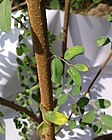Note: This is a project under development. The articles on this wiki are just being initiated and broadly incomplete. You can Help creating new pages.
Kirganelia reticulata
Kirganelia reticulata is large straggling shrub. It varies in habit from a much-branched, deciduous shrub 0.5 - 4.5 metres tall with long, thin often drooping branches, to a tree growing 5 - 18 metres tall. It sometimes adopts a more climbing habit. The stem is around 25cm in diameter.
Contents
[hide]- 1 Uses
- 2 Parts Used
- 3 Chemical Composition
- 4 Common names
- 5 Properties
- 6 Habit
- 7 Identification
- 8 List of Ayurvedic medicine in which the herb is used
- 9 Where to get the saplings
- 10 Mode of Propagation
- 11 How to plant/cultivate
- 12 Commonly seen growing in areas
- 13 Photo Gallery
- 14 References
- 15 External Links
Uses
Pitta, Burning sensation, Strangury, Gastropathy, Hemorrhages, Opthalmodynia, Sores, Burns, Smallpox, Asthma, Malaria.[1]
Parts Used
Chemical Composition
Common names
| Language | Common name |
|---|---|
| Kannada | Karisuli, Krishnanelli, Kaakinelli |
| Hindi | Panjoli |
| Malayalam | Kirganeli |
| Tamil | Karunelli |
| Telugu | Nallapurugudu |
| Marathi | NA |
| Gujarathi | NA |
| Punjabi | NA |
| Kashmiri | NA |
| Sanskrit | Bahupraja, Bahupushpa |
| English | Black honey shrub |
Properties
Reference: Dravya - Substance, Rasa - Taste, Guna - Qualities, Veerya - Potency, Vipaka - Post-digesion effect, Karma - Pharmacological activity, Prabhava - Therepeutics.
Dravya
Rasa
Guna
Veerya
Vipaka
Karma
Prabhava
Habit
Identification
Leaf
| Kind | Shape | Feature |
|---|---|---|
| Thin | Obalong | Elliptic or Spathulate |
Flower
| Type | Size | Color and composition | Stamen | More information |
|---|---|---|---|---|
| Borne in clusters | Yellow | Sexes seaparate on the same plant, Flowering before or with the new leaf | Flowering from September to April |
Fruit
| Type | Size | Mass | Appearance | Seeds | More information |
|---|---|---|---|---|---|
| Berry like | 4-6mm across | Blackish when ripe.Fruiting from September to April |
Other features
List of Ayurvedic medicine in which the herb is used
Where to get the saplings
Mode of Propagation
How to plant/cultivate
A plant of the moist tropics, it is found at elevations from 800 - 2,000 metres. Succeeds in most soils and a position in full sun or partial shade.[6]
Commonly seen growing in areas
Often forming thickets on floodplain grassland, Sand dune scrub, Rain-forest, Mixed deciduous woodlands, Miombo woodlands.
Photo Gallery
References
- Jump up ↑ Indian Medicinal Plants by C.P.Khare
- Jump up ↑ Karnataka Medicinal Plants Vol-2 by Dr.M.R.Gurudeva, Page no:163 and 164
- Jump up ↑ [Chemistry]
- Jump up ↑ Indian Medicinal Plants by C.P.Khare
- Jump up ↑ Kappatagudda - A Repertoire of Medicianal Plants of Gadag by Yashpal Kshirasagar and Sonal Vrishni, Page No. 248
- Jump up ↑ Useful tropical plants by The ferns.Information
External Links
- Pages using duplicate arguments in template calls
- Ayurvedic Herbs known to be helpful to treat Pitta
- Ayurvedic Herbs known to be helpful to treat Burning sensation
- Ayurvedic Herbs known to be helpful to treat Strangury
- Ayurvedic Herbs known to be helpful to treat Gastropathy
- Ayurvedic Herbs known to be helpful to treat Hemorrhages
- Ayurvedic Herbs known to be helpful to treat Opthalmodynia
- Ayurvedic Herbs known to be helpful to treat Sores
- Ayurvedic Herbs known to be helpful to treat Burns
- Ayurvedic Herbs known to be helpful to treat Smallpox
- Ayurvedic Herbs known to be helpful to treat Asthma
- Ayurvedic Herbs known to be helpful to treat Malaria
- Herbs with Leaves used in medicine
- Herbs with Root used in medicine
- Herbs with Bark used in medicine
- Herbs with Fruits used in medicine
- Herbs with common name in Kannada
- Herbs with common name in Hindi
- Herbs with common name in Malayalam
- Herbs with common name in Tamil
- Herbs with common name in Telugu
- Herbs with common name in Sanskrit
- Herbs with common name in English
- Habit - Deciduous Shrub
- Index of Plants which can be propagated by Seed
- Herbs that are commonly seen in the region of Often forming thickets on floodplain grassland
- Herbs that are commonly seen in the region of Sand dune scrub
- Herbs that are commonly seen in the region of Rain-forest
- Herbs that are commonly seen in the region of Mixed deciduous woodlands
- Herbs that are commonly seen in the region of Miombo woodlands
- Herbs
- Pages without herbs images








